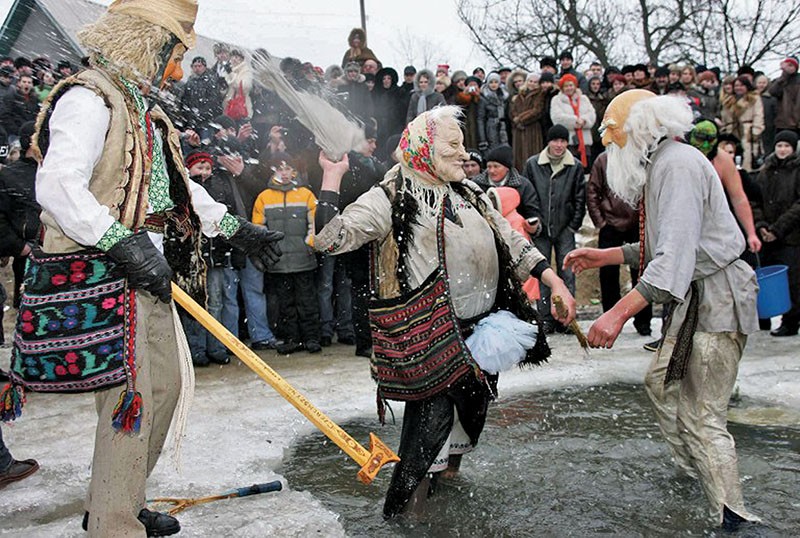Every year on Jan. 14, Ukraine celebrates “the old New Year” – the New Year by the Julian Calendar, by which the country lived until 1918. This old holiday also coincides in Ukraine with Malanka, a traditional carnival-like holiday from pre-Christian times.
“It’s a kind of a Ukrainian masquerade,” says ethnologist Inna Kuklina, an employee of Kyiv’s open-air Pyrohovo Museum of Folk Architecture and Life of Ukraine. “There was no hard work in winter, so young men could take part in this rite. The New Year wasn’t as important in a religious sense as, for example, Christmas, so the old pre-Christian rituals were preserved in the Malanka celebrations.”
Ritual and characters
The Malanka feast name comes from St. Melania Day, celebrated on Dec. 31, which by the old Julian calendar falls on Jan. 13.
The Malanka celebrations mark the arrival of the New Year and begin after sunset on the evening of St. Melania day on Jan. 13, which is also called the Generous Evening (Shchedryi Vechir) in Ukraine. The celebration’s participants dress as the characters involved in the ritual – Malanka, Vasyl, the She-Goat, the Old Man, the Gypsy, the Doctor, the Cat, and others – and hit the streets of Ukrainians villages and towns.
Malanka is usually portrayed by a young man dressed in a woman’s clothes. His makeup is bizarre – the face is whitened with chalk, the eyebrows are darkened with soot, and the cheeks are painted red with beet juice. Malanka is portrayed as a clumsy housewife whose housekeeping efforts make everybody laugh.
“It was a hint to young men that they should choose a good wife, since the New Year and Christmas celebrations were followed by the marriage season,” Kuklina says.
The She-Goat
While the Malanka character is prominent in the masquerade, the She-Goat character also stands out: the goat is a symbol of wealth and prosperity.
The performers lead the She-Goat on a leash (in Ukrainian the ritual is called “vodyty kozu” – “walking the goat”). The Goat is played by a young man in a mask and a sheepskin coat worn inside out. A skit is acted out in which the Goat starts to hit everybody in the house with its horns. At the end of the skit, the goat is shot and dies. Its death symbolizes the winter period and the death of all the plants, according to Kuklina.
But the climax of the ritual is the Goat’s resurrection. The Doctor and all the people present during the ritual try to bring the animal back to life. The doctor’s unsuccessful methods make everybody laugh – he peeks into goat’s ears, and counts its teeth to determine whether the goat is young or old.
When nothing helps, people even try to milk the Goat. Since it is played by a man, this trick usually “reanimates” the Goat quickly.
“The Goat’s dying and revival is the ritual’s central point, connected to agrarian cults symbolizing nature’s death and resurrection,” Kuklina says.
The Malanka ritual is also connected with the cult of the dead.
“Our predecessors believed that the beginning of a new life is not possible without the consent of the dead relatives,” the ethnologist said.
Tradition’s revival
The pre-Christian Malanka New Year celebrations faded away during the Soviet times as the atheist communist regime suppressed religious and national traditions. But after Ukraine gained independence in 1991, the Malanka celebrations started to revive, especially in Western Ukraine.
Chernivtsi and Vashkivtsi in Chernivtsi Oblast are known as the some of the best places to go to see traditional Malanka celebrations.
But the citizens of Horoshova, a town of 2,000 people in Ternopil Oblast some 480 kilometers west of Kyiv, claim their Malanka is the biggest in Ukraine. Every year on Jan. 13, the town’s residents prepare a new program of Old New Year celebrations, which thousands of people from the area come to see.
“All residents of Horoshova aged between 3 and 50 years take part in the Malanka celebrations,” says 15-year-old Horoshova resident Viktoria Kozak. “People from the whole district come to see the Malanka Eve events. All our guests like our performances very much.”

Fancy-dressed people bath into cold water during the festival of Malanka, 14 January 2008 in a western Ukrainian village Vashkivtsi, about 550 km (342 miles) southwest of the capital Kiev. The local population traditionally celebrates Malanka on 13th of January, which is New Year’s Eve in accordance with the Julian calendar. AFP PHOTO/EVGEN KRAWS / AFP PHOTO / EVGEN KRAWS
The people of Horoshova add modern characters to the Malanka performance – police officers, politicians, soldiers, and dictators. Russian President Vladimir Putin is sometimes featured in the performance.
It took Kozak two full days to prepare the costume of a mythical creature that she will to wear for this year’s Malanka celebrations. She is looking forward to the Jan. 13 night.
“I like how the young men are funnily dressed as Malankas,” she says.
To take part in Malanka celebrations, visit the Mamayeva Sloboda outdoor museum.
On Jan. 14 at 12 p.m. the Mamayeva Sloboda museum invites everybody to celebrate Old New Year according to Ukrainian traditions. The festive program includes the Malanka ritual, as well as Christmas carols, traditional Ukrainian dances,and lots of tasty food.
Mamayeva Sloboda is located on 2 Mykhayla Dontsya St. and is open daily from 10 a.m. until 6 p.m. To get there via public transport, take a trolleybus from Petrivka metro station or minibus No. 201 or No. 232 from Shuliavska metro station to Mykhayla Dontsya Steet bus stop. The entrance ticket is Hr 50 for adults, and Hr 35 for schoolchildren, students and pensioners.
